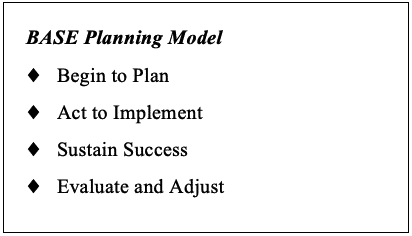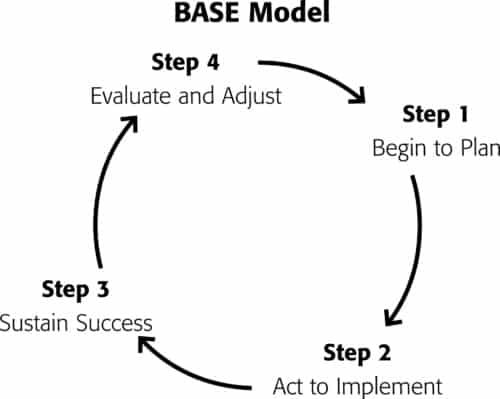Table of Contents
We’ve been involved in many planning projects and have come to appreciate that schools are constantly changing and improving. This continuous improvement process is described in many ways, but we’ve developed our BASE model to describe a four-step process for improvement in 4 Ways to Implement Change. We chose BASE because everything you do to improve your school must be built on a solid base that reflects research and best practice, builds support among teachers and families, and includes solid measures for success.
The four stages of the BASE model reflect a commitment to continuous improvement.
 The model provides a way to organize the steps you will take to achieve your vision for school improvement. It is circular in nature and assumes that to sustain improvement you must study how you have done and that this study will naturally lead to identifying additional ways your school can continue to improve.
The model provides a way to organize the steps you will take to achieve your vision for school improvement. It is circular in nature and assumes that to sustain improvement you must study how you have done and that this study will naturally lead to identifying additional ways your school can continue to improve.
Step 1: Begin to Plan
There are 5 strategies to use as you begin to plan. These can be used separately or together to build a foundation for the rest of the change process.
• Use an Inclusive Process—include a wide variety of stakeholders.
• Be Clear About Group Norms and Operations—set guidelines and stick to them to retain focus.
• Identify a Process for Making Decisions—this allows you to be clear and to keep everyone on task.
• Anchor Your Plan in a Shared Vision—discuss the vision from the school or district to get everyone on board, or create a shared vision with your stakeholders.
• Commit to the Use of Data—make decisions based on data, rather than personal opinions.
Step 2: Act to Implement the Plan
As complex as planning can be, implementing and sustaining those changes can be even more of a challenge. It is the implementation that forces people to face the reality that things “may be different.” The reality of implementation can provoke a range of feelings including regret over abandoning familiar practices, exhilaration at the prospect of new ideas, or of being overwhelmed by the complexity of doing something new.
There are several strategies and tools that you may want to consider as you work to improve your school.
• Have a Plan for Monitoring the Implementation—decide on specific monitoring and assessment tools
• Look at the Data—go back to the data you looked at as you prepared for change, and consider new data you have gathered
• Provide Time to Reflect on and Discuss the Issues—don’t rush the process. Let everyone think about and discussing the changes, both individually and in groups.
• Don’t Rush to Judgment—remember that change takes time and adjustments, so don’t give up too soon.
• Make Appropriate Adjustments—rather than giving up, evaluate what is happening and make the needed changes.
• Nurture a Collegial Culture—build relationships with your teachers, and help them positively relate to each other,
• Remove Barriers to Action—identify what is hindering progress and determine how to remove it.
• Constructively Deal with Conflict-build on your norms and process to deal with conflict and purposely include procedures for follow when conflict occurs.
• Establish Accountability for Results—determine specific criteria that will help you determine if your change is successful, ideally in the preparation process.
Step 3: Sustain Success
We’ve found that when your work is guided by a shared vision and where teachers and other school staff are actively involved in planning and implementation that change is more likely to be sustained. When change is the result of the personal vision of one or two people, the change is more likely to be abandoned as soon as its advocates leave. It is critical, therefore, that leaders create a culture that supports innovation and builds capacity for long-term changes in their school’s program. The third step of our planning model focuses on sustaining success.
• Continue to Provide Support for Success—build on your successes and don’t rest on your laurels.
• Monitor the Implementation—continue your evaluation strategies and make adjustments as needed.
• Identify Time for Collaboration—ensure that stakeholders have time to discuss and plan for the ongoing collaboration.
• Create a Culture of Continuous Improvement—remind everyone that change is continuing and that the process isn’t over, even if stakeholders feel like they have accomplished the goal.
• Use Data to Study the Results—we’ve discussed this before, but remember: Data, Data, Data!!
• Identify Successes and Celebrate—Although you should address challenges, always start with sharing successes and applaud those efforts.
Step 4: Evaluate and Adjust
 The very best schools constantly monitor their performance and identify ways to continue to make improvements. The final stage of our BASE planning model is to “Evaluate and Adjust.” As we said, the planning process is circular. The decisions you make during this stage will naturally lead you to continue planning to become even better.
The very best schools constantly monitor their performance and identify ways to continue to make improvements. The final stage of our BASE planning model is to “Evaluate and Adjust.” As we said, the planning process is circular. The decisions you make during this stage will naturally lead you to continue planning to become even better.
As with the other steps there are several important considerations. Because we discussed them earlier we will not repeat them, but here are some of the most important activities for evaluating and adjusting your plan.
• Ensure Positive Dynamics Among School Personnel—be positive and encourage all stakeholders to be positive, especially by insisting that everyone share at least one positive example related to the process before they share any challenges. Follow your norms for positively dealing with conflict.
• Data, Data, Data—revisit the original data that prompted the change, explain how data informed the process, and show current data that confirms what you did.
• Share What You Are Doing—be sure to explain the process and the positive aspects of the changes. Explain challenges you have overcome and ensure the support of all stakeholders.
A Final Note
Change is an ongoing process. By following the BASE model, you can ensure a more successful implementation of a change initiative.
- edCircuit – 3 Strategies for Hiring New Teachers
- edCircuit – 3 Keys to Effective Questioning
- Education Dive – Higher expectations, new strategies can boost test rigor
Subscribe to edCircuit to stay up to date on all of our shows, podcasts, news, and thought leadership articles.






